Instruction
Fingerprints of your swing: More thoughts from Phil Blackmar (with Tom Stickney)
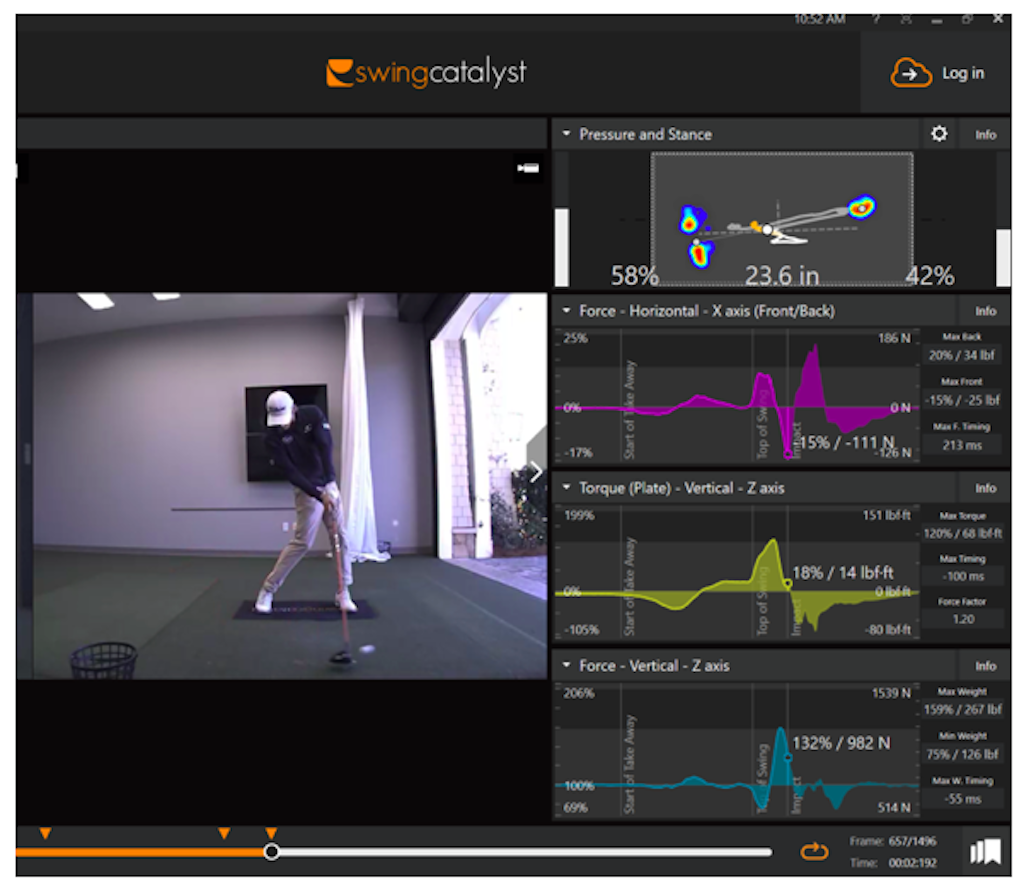
One of the biggest debates in the instructional world is the “way” in which people should use technology within their lessons. Some of the older pros are dead against it and say we have gone too far (Brandel Chamblee). Other pros like to blend feels and science (Phil Blackmar). Finally, some of the pros around think it’s great and wished it was around when they were playing (Frank Noblio). Personally, I think they are all correct!
Mechanics are important. You can’t expect to have the best results possible on the diagnostic end without technology to help you “see” things. On the other end, feels are one of the main tools of concentration used to navigate the course and the multitude of situations which arise. Feels may not be real, as they say, but they are incredibly important.
No two PGA Tour players swing exactly alike. While there are many similarities, every player on tour has learned the value of owning their swing which requires recognizing personal idiosyncrasies. These idiosyncrasies are called Fingerprints.
Phil Blackmar, a long-time PGA Tour Player and multiple winner defines these fingerprints as, “the idiosyncratic motions of the player that binds the swing together under pressure while allowing the player to adjust to any situation.” These fingerprints can be either physical (which we’ll focus on here) or part of the mental game as well.
Fingerprints are the baseline of your personal motion and have several levels. The levels range from aspects of the swing that cannot be changed without risking swing purgatory to ones that may change from week to week or even day to day. Imagine recording these in a notebook to keep them straight and to remember them. Use the first pages to record the permanent fingerprints progressing to the latter pages which relate more to feel keys that change often. Remember, a feel key that ends up lasting a long time may be transferred to a more permanent notebook location.
So, let’s dive in further on Phil’s fingerprints and seed how valuable they can be to you and I as we grow and mature as players.
Notebook Page One
Things that never change and are the backbone of the player’s swing.
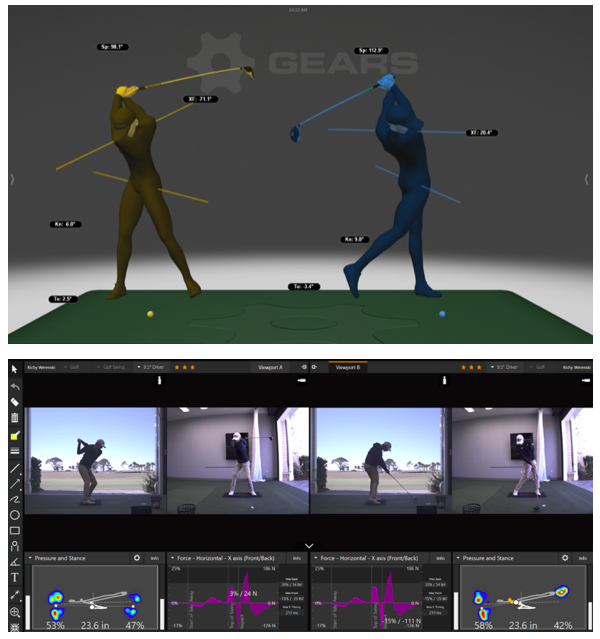
- You must turn back and forth during the swing
- There is movement of the pressure back and forth from foot to foot
- The clubshaft returns to impact as a solid unit on the lead side to compress the ball.
- The rear hip stays on or inside the rear foot.
- The swing happens in a sequence, turn, turn swoosh. Following the initiation of the second
- turn, the club swings into impact where it makes a swoosh.
These are the simple ones that all great players possess, but what about page number two? Page two is very important. It is like your personal swing DNA that encodes the things that make your swing unique to you. Care must be taken if changing a fingerprint because it can cost the player his or her swing personality. If this is lost, so too is the game as seen in several instances on the PGA tour.
Notebook Page Two
Things that rarely change and give the player their distinctive look

Here we have Jon Rahm at the top of the backswing and Bryson at address, which are both very unique. Imagine Rahm trying to stand to the ball like Bryson or Bryson with Rahm’s short laid-off backswing. That would be a disaster for them both just like Rahm will never swing it back like Daly or Adam Scott and Bryson will never lower his hands at address like Fuzzy.
You can try and alter things to see if they work better. But, this is where the instructor must respect the feels of the player because such changes may be going up against the player’s unique DNA or fingerprint. It should be a shared journey of discovery between the player and the instructor.
In fact, Justin Rose said this about his own swing while working with Sean Foley:
“My normal MO would be to get the club into a very toe-down position at the top of my backswing and I would have to work hard to square the face at impact. As a young player, this was a way of creating speed. Because of that, my head tends to stay back through impact as well. But those are my traits and the ones I’ve had a really hard time getting rid of, but in some ways they’re my talent. This is how I play golf. I’m not a guy who is closed and super-strong at the top of the backswing and that holds the face very passive through impact, and thankfully Sean understood that and didn’t try and change it.”
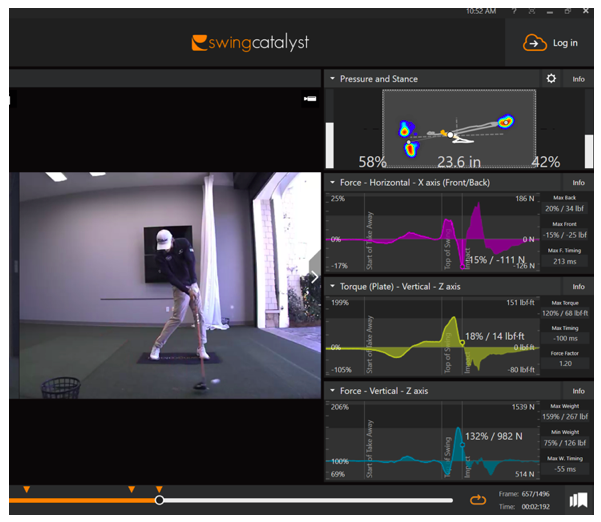
Notebook Page Three
Fundamentals that can become fractionally more malleable
These could include such swing aspects as grip, ball position, alignment, width of stance, distance from the ball, club face orientation etc. Remember, just because something looks different or odd it is not necessarily a flaw. While it could be, it also could be a fingerprint so take care in making changes.
So let’s look at this sample swing from this player and see how Page Three would operate.
Everything looks pretty good, but let’s say we (both the player in instructor) felt like he was leaving some power behind and we decided to audit his force production on Swing Catalyst. And as we see above the horizontal force isn’t quite as strong as it should be.
Next, we check GEARS to see what is going on with how he moves his pelvis.
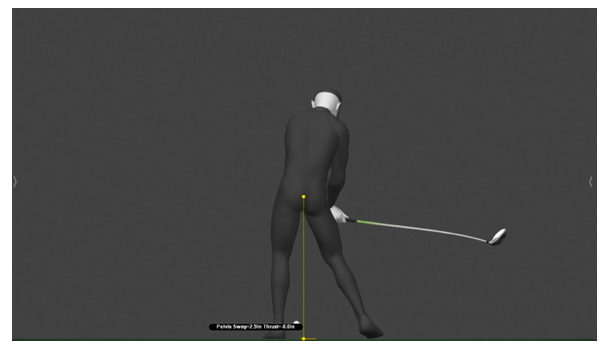
We see that his pelvis has just traveled a few inches forward by this point in his swing and that’s the root of his horizontal force problem. Too little movement too late in the downswing. (3D Rocks!)
Question though?? Could we make his horizontal force grow and peak earlier for added power? We could try, but would that necessarily make this player better? The only way we could find out is to test it subtly and see what happens. As a teacher, however, I will tread lightly because this appears so natural to this player.
Page Four of the Notebook
Things that can change from week to week or even day to day.
These are the carrots of knowledge or epiphanies which you discover in the middle of the night, on the range during warm-up, on the course and so on. These can be very powerful and can turn a bad day into good, a good day into better or just salvage a round. Great players are experts and limiting damage until they can find a feel key to get them to the house so they live to fight another day.
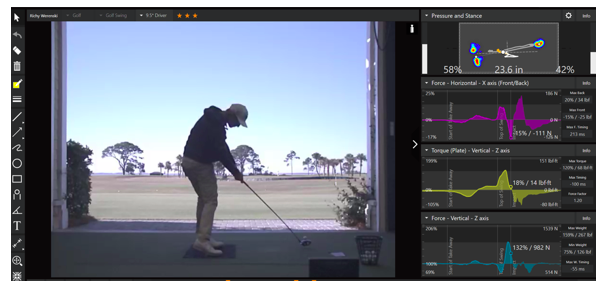
Picture this player struggling with shots hanging right.
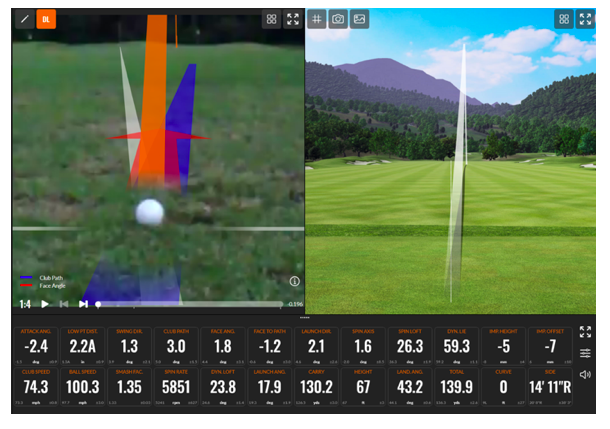
We audit TrackMan to see what is happening we find the path and face are fine but the player is catching the ball off of the heel. This ball should have been a wonderful push draw that we like to see but the heel strike countered it and made the ball hang out to the right.
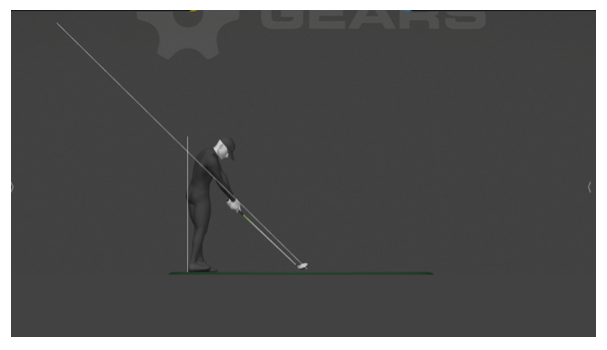
So as we go back and reflect on our notebook, this isn’t a major issue so let’s think about a simple swing key that would help this player without reinventing the wheel.
Is it a page one fingerprint issue- No?
Is it a page two fingerprint issue- No?
It appears to be a page four issue where the player simply needs to focus more on balance and make contact with the intent of finding the middle of the face. So, we experiment with a couple feels and find if he keeps his balance over the middle of his feet rather than toes, the heel shot goes away.
So, this player hits balls and says, “YES, I have it…I’ll just wiggle my toes at address and it will remind me to stay back more towards my heels.” This is an example of opening your notebook and making sure you don’t go off on a tangent trying to fix major things when a simple thought could help. Consistency is born in simplicity, not complexity.
Today it will be wiggling the toes, two days from now it might be focus on hitting the center of the blade, and next week it might be something as radical as “X.” The bottom line is that if items on the first pages of the notebook haven’t changed, then the answer can usually be found in a simple manner.
Concentration, the topic of another blog, uses subconscious pictures and feels to remember the shot before the swing begins. It’s a process that is most efficient with narrow focus rather than multiple concerns. The player who, on the course, can narrow focus while remaining calm, remember the shot prior to swinging, and swing with certainty, is the player most likely to excel in all situations. Mechanics and feels must walk the fairways together.
Instruction
The Wedge Guy: Beating the yips into submission

There may be no more painful affliction in golf than the “yips” – those uncontrollable and maddening little nervous twitches that prevent you from making a decent stroke on short putts. If you’ve never had them, consider yourself very fortunate (or possibly just very young). But I can assure you that when your most treacherous and feared golf shot is not the 195 yard approach over water with a quartering headwind…not the extra tight fairway with water left and sand right…not the soft bunker shot to a downhill pin with water on the other side…No, when your most feared shot is the remaining 2- 4-foot putt after hitting a great approach, recovery or lag putt, it makes the game almost painful.
And I’ve been fighting the yips (again) for a while now. It’s a recurring nightmare that has haunted me most of my adult life. I even had the yips when I was in my 20s, but I’ve beat them into submission off and on most of my adult life. But just recently, that nasty virus came to life once again. My lag putting has been very good, but when I get over one of those “you should make this” length putts, the entire nervous system seems to go haywire. I make great practice strokes, and then the most pitiful short-stroke or jab at the ball you can imagine. Sheesh.
But I’m a traditionalist, and do not look toward the long putter, belly putter, cross-hand, claw or other variation as the solution. My approach is to beat those damn yips into submission some other way. Here’s what I’m doing that is working pretty well, and I offer it to all of you who might have a similar affliction on the greens.
When you are over a short putt, forget the practice strokes…you want your natural eye-hand coordination to be unhindered by mechanics. Address your putt and take a good look at the hole, and back to the putter to ensure good alignment. Lighten your right hand grip on the putter and make sure that only the fingertips are in contact with the grip, to prevent you from getting to tight.
Then, take a long, long look at the hole to fill your entire mind and senses with the target. When you bring your head/eyes back to the ball, try to make a smooth, immediate move right into your backstroke — not even a second pause — and then let your hands and putter track right back together right back to where you were looking — the HOLE! Seeing the putter make contact with the ball, preferably even the forward edge of the ball – the side near the hole.
For me, this is working, but I am asking all of you to chime in with your own “home remedies” for the most aggravating and senseless of all golf maladies. It never hurts to have more to fall back on!
Instruction
Looking for a good golf instructor? Use this checklist

Over the last couple of decades, golf has become much more science-based. We measure swing speed, smash factor, angle of attack, strokes gained, and many other metrics that can really help golfers improve. But I often wonder if the advancement of golf’s “hard” sciences comes at the expense of the “soft” sciences.
Take, for example, golf instruction. Good golf instruction requires understanding swing mechanics and ball flight. But let’s take that as a given for PGA instructors. The other factors that make an instructor effective can be evaluated by social science, rather than launch monitors.
If you are a recreational golfer looking for a golf instructor, here are my top three points to consider.
1. Cultural mindset
What is “cultural mindset? To social scientists, it means whether a culture of genius or a culture of learning exists. In a golf instruction context, that may mean whether the teacher communicates a message that golf ability is something innate (you either have it or you don’t), or whether golf ability is something that can be learned. You want the latter!
It may sound obvious to suggest that you find a golf instructor who thinks you can improve, but my research suggests that it isn’t a given. In a large sample study of golf instructors, I found that when it came to recreational golfers, there was a wide range of belief systems. Some instructors strongly believed recreational golfers could improve through lessons. while others strongly believed they could not. And those beliefs manifested in the instructor’s feedback given to a student and the culture created for players.
2. Coping and self-modeling can beat role-modeling
Swing analysis technology is often preloaded with swings of PGA and LPGA Tour players. The swings of elite players are intended to be used for comparative purposes with golfers taking lessons. What social science tells us is that for novice and non-expert golfers, comparing swings to tour professionals can have the opposite effect of that intended. If you fit into the novice or non-expert category of golfer, you will learn more and be more motivated to change if you see yourself making a ‘better’ swing (self-modeling) or seeing your swing compared to a similar other (a coping model). Stay away from instructors who want to compare your swing with that of a tour player.
3. Learning theory basics
It is not a sexy selling point, but learning is a process, and that process is incremental – particularly for recreational adult players. Social science helps us understand this element of golf instruction. A good instructor will take learning slowly. He or she will give you just about enough information that challenges you, but is still manageable. The artful instructor will take time to decide what that one or two learning points are before jumping in to make full-scale swing changes. If the instructor moves too fast, you will probably leave the lesson with an arm’s length of swing thoughts and not really know which to focus on.
As an instructor, I develop a priority list of changes I want to make in a player’s technique. We then patiently and gradually work through that list. Beware of instructors who give you more than you can chew.
So if you are in the market for golf instruction, I encourage you to look beyond the X’s and O’s to find the right match!
Instruction
What Lottie Woad’s stunning debut win teaches every golfer

Most pros take months, even years, to win their first tournament. Lottie Woad needed exactly four days.
The 21-year-old from Surrey shot 21-under 267 at Dundonald Links to win the ISPS Handa Women’s Scottish Open by three shots — in her very first event as a professional. She’s only the third player in LPGA history to accomplish this feat, joining Rose Zhang (2023) and Beverly Hanson (1951).
But here’s what caught my attention as a coach: Woad didn’t win through miraculous putting or bombing 300-yard drives. She won through relentless precision and unshakeable composure. After watching her performance unfold, I’m convinced every golfer — from weekend warriors to scratch players — can steal pages from her playbook.
Precision Beats Power (And It’s Not Even Close)
Forget the driving contests. Woad proved that finding greens matters more than finding distance.
What Woad did:
• Hit it straight, hit it solid, give yourself chances
• Aimed for the fat parts of greens instead of chasing pins
• Let her putting do the talking after hitting safe targets
• As she said, “Everyone was chasing me today, and managed to maintain the lead and played really nicely down the stretch and hit a lot of good shots”
Why most golfers mess this up:
• They see a pin tucked behind a bunker and grab one more club to “go right at it”
• Distance becomes more important than accuracy
• They try to be heroic instead of smart
ACTION ITEM: For your next 10 rounds, aim for the center of every green regardless of pin position. Track your greens in regulation and watch your scores drop before your swing changes.
The Putter That Stayed Cool Under Fire
Woad started the final round two shots clear and immediately applied pressure with birdies at the 2nd and 3rd holes. When South Korea’s Hyo Joo Kim mounted a charge and reached 20-under with a birdie at the 14th, Woad didn’t panic.
How she responded to pressure:
• Fired back with consecutive birdies at the 13th and 14th
• Watched Kim stumble with back-to-back bogeys
• Capped it with her fifth birdie of the day at the par-5 18th
• Stayed patient when others pressed, pressed when others cracked
What amateurs do wrong:
• Get conservative when they should be aggressive
• Try to force magic when steady play would win
• Panic when someone else makes a move
ACTION ITEM: Practice your 3-6 foot putts for 15 minutes after every range session. Woad’s putting wasn’t spectacular—it was reliable. Make the putts you should make.
Course Management 101: Play Your Game, Not the Course’s Game
Woad admitted she couldn’t see many scoreboards during the final round, but it didn’t matter. She stuck to her game plan regardless of what others were doing.
Her mental approach:
• Focused on her process, not the competition
• Drew on past pressure situations (Augusta National Women’s Amateur win)
• As she said, “That was the biggest tournament I played in at the time and was kind of my big win. So definitely felt the pressure of it more there, and I felt like all those experiences helped me with this”
Her physical execution:
• 270-yard drives (nothing flashy)
• Methodical iron play
• Steady putting
• Everything effective, nothing spectacular
ACTION ITEM: Create a yardage book for your home course. Know your distances to every pin, every hazard, every landing area. Stick to your plan no matter what your playing partners are doing.
Mental Toughness Isn’t Born, It’s Built
The most impressive part of Woad’s win? She genuinely didn’t expect it: “I definitely wasn’t expecting to win my first event as a pro, but I knew I was playing well, and I was hoping to contend.”
Her winning mindset:
• Didn’t put winning pressure on herself
• Focused on playing well and contending
• Made winning a byproduct of a good process
• Built confidence through recent experiences:
- Won the Women’s Irish Open as an amateur
- Missed a playoff by one shot at the Evian Championship
- Each experience prepared her for the next
What this means for you:
• Stop trying to shoot career rounds every time you tee up
• Focus on executing your pre-shot routine
• Commit to every shot
• Stay present in the moment
ACTION ITEM: Before each round, set process goals instead of score goals. Example: “I will take three practice swings before every shot” or “I will pick a specific target for every shot.” Let your score be the result, not the focus.
The Real Lesson
Woad collected $300,000 for her first professional victory, but the real prize was proving that fundamentals still work at golf’s highest level. She didn’t reinvent the game — she simply executed the basics better than everyone else that week.
The fundamentals that won:
• Hit more fairways
• Find more greens
• Make the putts you should make
• Stay patient under pressure
That’s something every golfer can do, regardless of handicap. Lottie Woad just showed us it’s still the winning formula.
FINAL ACTION ITEM: Pick one of the four action items above and commit to it for the next month. Master one fundamental before moving to the next. That’s how champions are built.
PGA Professional Brendon Elliott is an award-winning coach and golf writer. You can check out his writing work and learn more about him by visiting BEAGOLFER.golf and OneMoreRollGolf.com. Also, check out “The Starter” on RG.org each Monday.
Editor’s note: Brendon shares his nearly 30 years of experience in the game with GolfWRX readers through his ongoing tip series. He looks forward to providing valuable insights and advice to help golfers improve their game. Stay tuned for more Tips!









